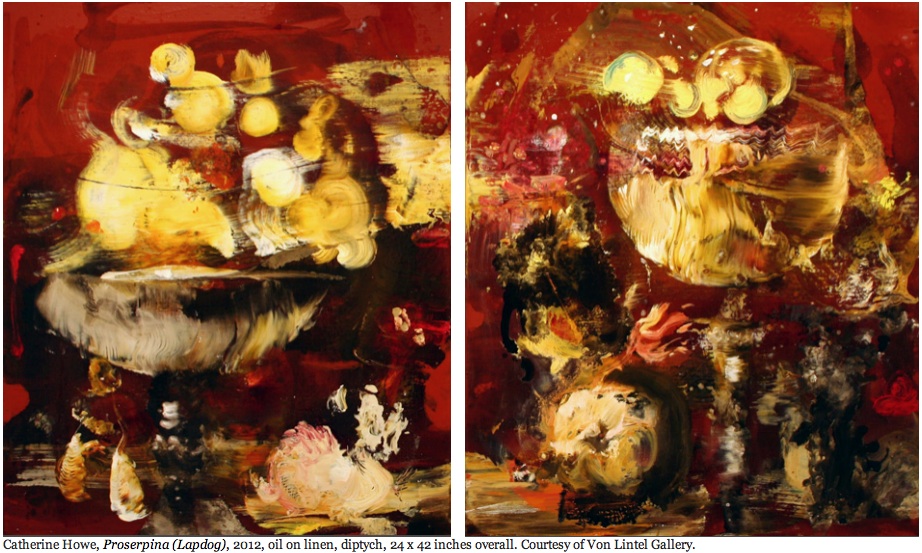Going Forward in Reverse: The Present Tense(ion) of History Painting (Banisadr, Howe, Dalwood, Steir, Taaffe, Quayola, Wang)
By G. Roger Denson | Cultural critic, essayist, novelist and screenwriter published with Parkett and Art in America

In the last decade, the painters Ali Banisadr, Dexter Dalwood, Catherine Howe, Pat Steir, Phillip Taaffe, and Suling Wang, along with one exceptional digital animator from London named simply Quayola, have produced remarkably strong painting as a result ot their immersions in the history of painting and other cultural forms. Whether the artist is paintings a still life (Catherine Howe), a battle scene (Ali Banisadr), a landscape (Suling Wang), a hybrid of popular and art history (Dexter Dalwood), or digitally programming chance algorithms in the production of video paintings (Quayola), each of these painters is redefining the meaning of History Painting with a specific ideological intent. As for those painters who have used art history as a departure for their work for decades, (Pat Steir and Phillip Taaffe), they can be seen producing some of their most spectacular work today as derived from the remnants of art and cultural history. Whether or not the new emphasis on art history originated as a consciously-deployed Conceptualist-styled defense against the proscription of painting pronounced by artists and critics of the 1970s and 1980s is a subject of debate. But either way, the strategy of premising painting in art history seems to have proven successful in anchoring the painterly productions of at least the seven artists featured here.
[...]
Catherine Howe has produced her generation's most sumptuously inviting yet socially-decadent conflations made in the name of painterly reflection. For the last twenty years she has painted some variation of expressionist figuration, usually with readily-apparent allusions to art history. Her most recent work, shown last spring at the Thomas Von Lintel Gallery in New York, applies the notion of expressionist entropy to her own singular rephrasing of the epoch of still life paintings issued in 16th- and 17th-century Netherlands and Flanders, the most famous being categorized under the rubrics of vanitas and pronk painting.
Howe especially lingers over exquisite portrayals of beautiful objects, both man-made and organic, envisioned by the Dutch and Flemish masters to convey the transience of life on earth. In this respect Howe disregards the severe and blunt vanitas paintings of skulls and decay in favor of over-ripe and peeled fruit, liquors languishing in pristine glassware, and the blooms of flowers showing the first signs of their demise to come. But above such significations, Howe esteems "the moment" that will endure forever in art, and like the Dutch vanitas painters, instead of chosing to memorialize the peak of beauty, she captures the lingering evidence of the party that has just ended, yet is still felt by its revelers in the flush of night-long intoxications. The pronk still lifes are especially valued by Howe for their extravagantly-rendered, shimmering-to-the-point-of-ostentatious details, thereby inviting the lurid sensibilities of the contemporary expressionist painter to exploit their reinterpretation in an orgy of sensual overindulgence.
Howe's overindulgence in sensuality, however, is intended to seduce us into lingering long over the thought that both expressionism and vanitas-pronk paintings place emphasis on the immediacy of observed nature. She regards the visual hedonism unleashed in such paintings to be the sustaining grasp on what otherwise would be an ultimately uncontrollable and altogether vain pursuit of pleasure. In her re-enactment of the Dutch and Flemish sense of the visceral, she intuits that painting expressionistically allows her to visually sustain the feeling of being vitally alive, even if for only a moment. "Despite that I'm slipping away," she wrote to me in an email, "I have this acutely felt moment." Naturally, such a desire to prolong the ecstasy of painting would draw Howe to art history, considering that history prolongs our sense of the moment "slipping away from us." Of course, it can be claimed by some theories of time that "the moment" is never "really" slipping away as much as it is transforming, perpetually, as an eternal "moment" of the present.
Read more @ Huffington Post
See more of Catherine Howe's work @ VON LINTEL GALLERY


No comments:
Post a Comment